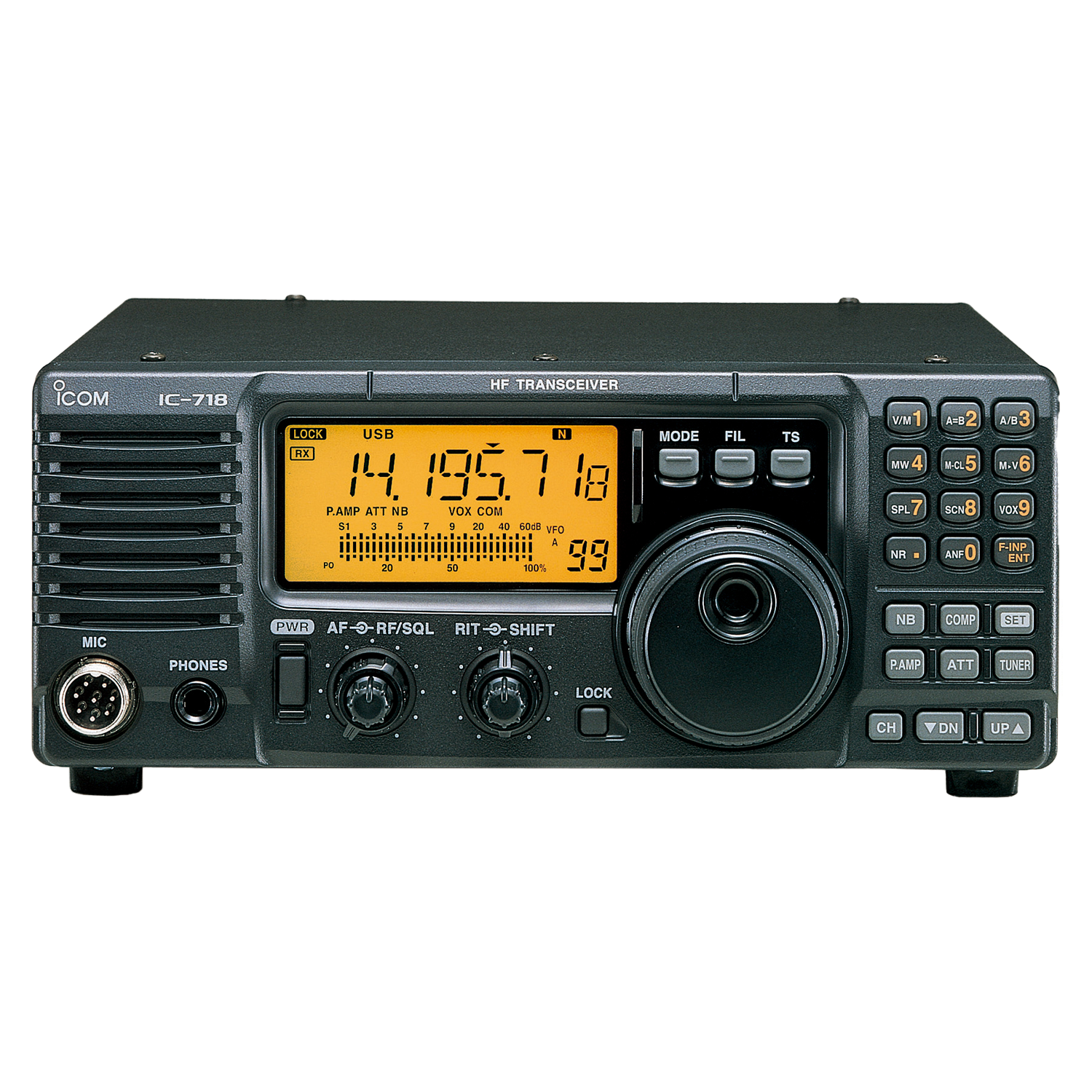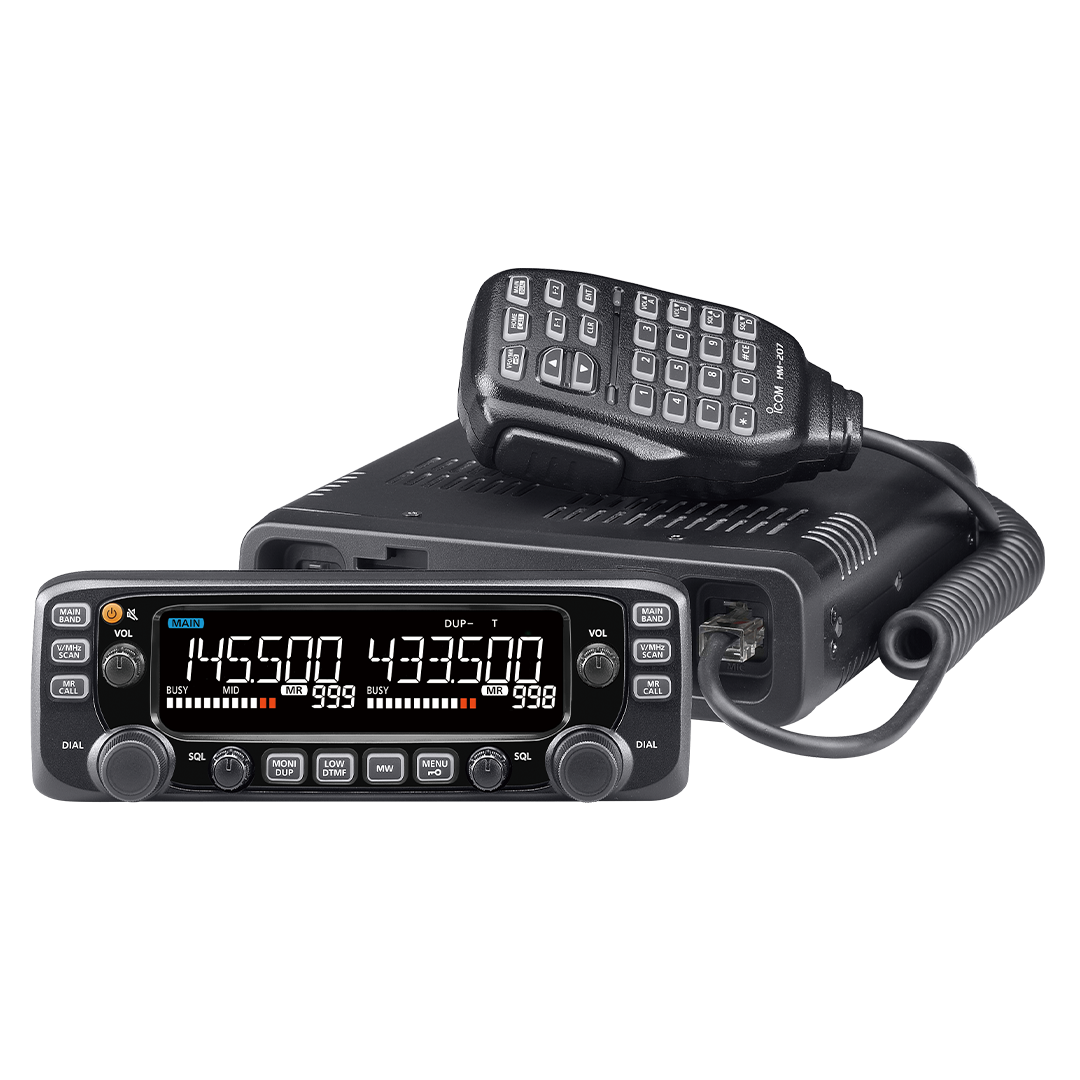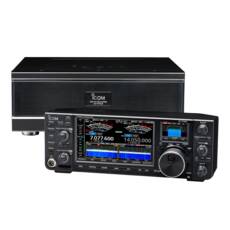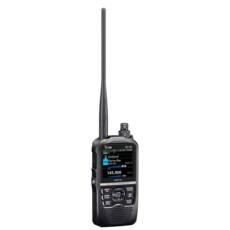Amateur Radio
- further categoriesThe DND Telecom Center webshop offers handheld, mobile and desktop amateur walkie-talkie radios from Icom and Midland. Icom and Midland offer a wide range of handheld, desktop and mobile amateur radios for anyone interested in amateur radio, as well as those who have all the necessary licenses. Japanese manufacturer Icom has over 40 years of experience in the field of amateur (HAM) radios. They have more amateur radio knowledge than almost anyone else. Icom is the market leader in amateur radio. From the start, Icom has been renowned for quality, innovation and design ... ask any amateur radio enthusiast about that. Read more...
• Tx frequency coverage: 144-146Mhz, 430-440Mhz
• Rx frequency coverage: 118-174Mhz, 375-550Mhz
• Maximum 50/15/5W RF output power
• F2D (FM) and F3E (FM-N) emission type
• 1052 memory channels
• 150x50x27,2mm large detachable display
• VHF/VHF, UHF/UHF simultanious receive
• Free of charge programming software
• Optional bluetooth headset
• Tx frequency coverage: HF frequencies
• Rx frequency coverage: 0,030-29,999999MHz
• Maximum 100W RF output power
• Front mounted loud speaker
• USB, LSB, CW, RTTY (FSK), AM mode
• 101 programmable memory channels
• Built-in CTCSS/DTCS encoder and decoder
• Equivalent to MIL-STD 810 C, D, E, and F requirements
• Tx frequency coverage: HF frequencies
• Rx frequency coverage: 0,030-74,800MHz
• Maximum 100W RF output power
• Large, touch screen colour TFT LCD display
• Real-time spectrum scope
• SSB, CW, RTTY (FSK), AM, FM mode
• 101 programmable memory channels
• All mode transceiver: HF/50/144/440 MHz
• D-STAR DV, SSB, CW, RTTY, AM és FM modes
• Output power: 10W
• Compact and lightweight design (LC-192 backpack as optional solution for carrying)
• Large touch screen color display
• Supplied accessories: DC power cable (OPC-2421), BP-272 battery(2000mAh), HM-243 microphone
• built in GPS antenna
• built in Bluetooth and WLAN
• microSD card slot
• optional antenna (not supplied accessorie): AL-705
• Tx frequency coverage: 144-146Mhz, 430-440Mhz
• Rx frequency coverage: 118-174Mhz, 375-550Mhz
• Maximum 50/15/5W RF output power
• High-contrast Large Black Inverted LCD
• F2D (FM) and F3E (FM-N) emission type
• 1052 memory channels
• 150x50x27,2mm large detachable display
• VHF/VHF, UHF/UHF simultanious receive
• Free of charge programming software
• Tx frequency coverage: 144.0-146.0; 430.0-440.0; 1240.0-1300.0MHz frequencies
• Rx frequency coverage: 144.0-146.0; 430.0-440.0; 1240.0-1300.0MHz frequencies
• Maximum 100W RF output power
• High resolution multi-function LCD display
• SSB, CW, RTTY, AM, FM, DV, DD mode
• Tx frequency coverage: 144-146Mhz, 430-440Mhz
• Rx frequency coverage: 118-174Mhz, 375-550Mhz
• Maximum 50/15/5W RF output power
• F2D (FM) and F3E (FM-N) and F7W (DV) emission type
• Integrated D-STAR mode
• Total 2254 memory channels
• 5,5" touch screen
• Integrated GPS receiver
• Free of charge software for PC and Android
• Optional bluetooth headset
• VHF: 144-146 MHz / UHF: 430-440 MHz
• Adjustable output power: (Hi: 5W / Low: 1W)
• CTCSS, DCS, DTMF, ANI
• Up to 128 memory channels
• FM Radio (88-108MHz)
• Large color display with backlight
• Li-Ion battery pack 1500 mAh
• 50 CTCSS tones and 208 DCS codes
• Frequency step: 2.5/5/6.25/10/12.5/25KHz
• 2pin Kenwood accessory jack
• SMA female antenna connector
• Tx frequency coverage: HF frequencies
• Rx frequency coverage: 0,030-60,000MHz
• Maximum 100W RF output power
• 7-inch colour display with touch screen function
• USB, LSB, CW, RTTY, PSK31/63, AM, FM mode
• 101 programmable memory channels
• 110dB Dynamic Range
• Built-in, high-speed automatic antenna tuner
• IP remote control connection with Ethernet connector
• Tx/Rx: 144-146 MHz, DV/FM
• Compatible with ID-RP2C controller
• Integrated Controller Function
• 25W RF output power
• Digital GMSK modulation
• CW ID/Voice ID transmitter
• SD card slot for firmware update, saving setting data and FM mode Voice ID audio
• 10 MHz reference signal input
• Tx/Rx: 430-440 MHz, DV/FM
• Compatible with ID-RP2C controller
• Integrated Controller Function
• 25W RF output power
• Digital GMSK modulation
• CW ID/Voice ID transmitter
• SD card slot for firmware update, saving setting data and FM mode Voice ID audio
• 10 MHz reference signal input
• Tx/Rx: between 1240-1300 Mhz, DV/DD/FM
• Compatible with ID-RP2C controller
• Integrated control function
• Maximum 10W RF output power
• Optional UX-262 LTE unit for wireless internet connection
• Data transfer rate of 4.8kbps (DV) and 128kbp (DD)
• Digital/analog mixed mode operation
• High duty cycle operation
• Tx: 144-146 / 430-440MHz
• Rx: 136–174 / 400–479 MHz
• FM broadcast receiver: 76–108 MHz
• 208 programmable channels with 6 character channel name
• Powerful 1500 mW audio output
• Maximum 5W RF output power
• Confirms with IP67 standard (waterproof and dust-tight protection)
• CTCSS, DTCS coder and encoder
• LCD display and full keypad
• 5 W RF Output in 144 and 430 MHz
• Home Button on Top Panel for Quick Access to Calling Channel
• Li-ion battery and rapid charger supplied as standard
• Free CS-T10 downloadable programming software
• Tx frequency coverage:144-146 / 430-440MHz
• Rx frequency coverage: 108-174 / 375-479MHz
• 5/2,5/1/0,5/0,1W RF output power
• Mode: DV, FM, FM-N, WFM, AM, AMN* (*cannot be received from 225 to 374.995 MHz)
• Built-in GPS receiver
• D-STAR DV mode (digital voice + data)
• V/V, U/U, V/U, double channel monitoring
• VHF/UHF airband and FM broadcast receiver
• Confirms with IPX7 standard (submersible construction)
• MicroSD card slot
• Improved and new software features
• Operates on 144, 430, 1200, 2400, 5600 MHz (all mode)
• The industry's first multiband 144 MHz to microwave transceiver
• SSB, CW, AM, FM, RTTY, D-STAR DV/DD and FM-TV (Amateur TV) modes
• Output power: 10W at 144, 430, 1200 MHz, 2W at 2400, 5600 MHz and 0.5W at 10 GHz (optional CX-10G required for 10 GHz operation)
• GPS-controlled oscillator for ultimate frequency stability
• Large touch screen with colour display
• microSD card interface (microSD card not supplied as standard)
• 500 memory channels divided into up to 100 groups
• USB Type-C connector
• TX and AFC (automatic frequency control) function
• Tx: 0.030-60.00 MHz
• Rx: 0.1357-0.1378; 1.810-1.999; 3.500-3.800; 7.000-7.200; 10.100-10.150; 14.000-14.350; 18.068-18.168; 21.000-21.450; 24.890-24.990; 28.000-29.700; 50.000-52.000 MHz
• Large multifunction LCD display
• Connectable to wired home LAN network (gigabit ethernet required)
• Maximum 200W RF output power
• USB, LSB, CW, RTTY, PSK31/63, AM, FM mode
• Built-in automatic antenna tuner
• Wireless Bluetooth connection to an Android device, even when using terminal mode and access point mode
• Dual operation between Terminal Mode and Simplex/Repeater operation
• Tx: 144-146 / 430-440MHz
• Rx: 108-174 / 375-479MHz
• Selectable 5/2.5/1/0.5/0.1W RF output power
• Modes of operation: FM, FM-N, WFM*, DV, AM*, AM-N* (*Rx only)
• Integrated GPS receiver
• Built-in D-Star mode
• Reception of VHF/UHF bands and FM radios
• IPX7 water resistance
• MicroSD card slot
• USB Type-C port for both charging and programming
Special gross price: 557.69€ (Net price: 439.12€)
• Tx frequency coverage: HF/50/70/144/430MHz
• Rx frequency coverage: 0,030-199,99 and 400-470MHz
• Maximum 100 RF output power
• Intuitive Touch Screen Interface
• 48,6 x 75,9 mm large resisitve touch screen display
• USB, LSB, CW, RTTY, AM, DV, FM, WFM mode
• D-STAR DV mode (digital voice + data)
• 495 regular memory channels and 900 D-STAR channels
• SD Memory Card Slot for Saving Data
We also offer digital amateur radios based on Icom's own D-STAR system. In addition, we can also provide Icom infrastructure for VHF, UHF and 1.2Ghz bands for the digital amateur radio system. Our range of Sirio and Diamond brand antennas includes recessed and magnet mount antennas specifically for the amateur band, rooftop antennas and handheld radio antennas.
Framework for Amateur Radio
Amate radio operators are people whose hobby or passion is to operate (or perhaps build) radio transceivers, with an official licence from the authorities of the country concerned, and to use them to establish contact with amateur radio operators elsewhere in the world. Radio amateurs also carry out radio orienteering, gyro-gramming and speed radio (Morse code), all of which are radio activities of a sporting nature. The DND Telecom Center webshop makes it easy to get the equipment you need for all these activities.
About the Icom brand
The founder of the Japanese company, Tokuzo Inoue, became obsessed with radio as early as high school. And after a visit to a radio shop, he decided to dedicate his life to wireless communications. It was in this spirit that he founded Icom in Osaka, Japan, in 1954. Today, the company's products are found all over the world, and Icom has offices in the US, England, France and Germany.
Icom founded the company in Oceania, Japan, in 1953.
About the Midland brand
A US company that has been at the forefront of radio technology for 50 years, with CB radios and 14-channel FRS radios offering ground-breaking solutions, and a Kansas company that is a market leader in radio stations, transceivers and emergency radios. With a product range that is popular in Europe and Asia as well as America, Midland amateur radios are a reliable and safe choice.
What you need to know about the amateur radio exam
Amateur radio licence can be obtained after passing the amateur radio exam. The CEPT-type exam gives amateur radio operators the right to operate their radio stations without a special licence during short visits to CEPT member countries.If you want to become an amateur radio operator, you can choose between three options: basic, intermediate or harmonised amateur radio operator exam (HAREC level). The minimum age for the basic and HAREC exams is 14 years, while the minimum age for the entry level is 16 years. For all three examinations, it is possible to combine them with a Morse code examination, either simultaneously or separately.
The detailed conditions are laid down in the NMHH Decree 15/2013 (25.IX.) on the Amateur Radio Service, but the law does not specify how to prepare for the exam. Therefore, there are several options: preparation courses, radio club preparation, online learning or the classic textbook solution.
The exam itself consists of an oral and a written part. The latter consists of a multiple-choice test, some easy calculations, a drawing and a few essay questions on basic technical, safety and legal knowledge, radio distribution and abbreviations. The oral part is also an exercise, as the candidate has to conduct real, regular radio communications with the examiner in the other room. After a successful examination, the amateur radio licence is issued. After that, you can indulge in your passion and use your desktop, mobile or hand-held amateur radio.
What frequency range do amateur walkie-talkies cover?
In our country, it is currently possible to radio in two frequency bands, subject to the rules, without a special licence. One is the frequency band between 26.965 MHz and 27.405 MHz, the other is the so-called PMR frequency band, which modulates between 446.00625 MHz and 446.19375 MHz. However, with a CEPT exam, several other amateur radio bands can be used.
What is the power and range of amateur radio?
This largely depends on what kind of amateur radio you are using. Most of the Icom mobile and desktop amateur walkie-talkie radios available in the DND Telecom webshop have a maximum RF output power of 100W, but you can also choose one with a RF output power of 50/15/5W. However, the handheld amateur radios have an output power of up to 5W RF. Amateur radios have a long range of up to hundreds or thousands of kilometres.
When using amateur radios, is it possible to transmit at different power levels?
Amateur radios mostly operate in two frequency bands. One is UHF, which uses 400-480-520 MHz, and the other is VHF, which broadcasts between 136 and 176 MHz. In addition, amateur radios have their own memory, so they can save many channels. Most of these types of radios are dual-channel, i.e. you can listen to two frequencies at the same time, but only one channel at a time. This is a big advantage, as it makes your job much easier.
What types of modulation does amateur radio support?
Amateur radios use a variety of modulation types. For example, the single sideband mode, abbreviated SSB, the telegraph mode, abbreviated CW, AM and FM, and USB modulation, which covers the upper sideband and LSB, which covers the lower sideband, but also worth mentioning is RTTY modulation, which is used by radio amateurs at 45 baud.
Does your amateur transceiver radio include a noise cancelling function?
The Icom and Midland amateur radios available in the DND Telecom webstore support noise cancellation for clearer sound. But it's worth choosing a radio that also has a wind noise suppression function. When used in a windy environment, the amateur radio will automatically switch to Speaker-As-Mic mode, which stands for SAM.
But the automatic acoustic feedback attenuator function can also be useful when two amateur radios are near each other. Without this feature, sound quality can deteriorate. Therefore, if crystal clear sound is important to you, make sure you have it.
What power sources does your amateur radio use?
Handheld amateur radios are mostly powered by a 2280 mAh Li-Ion battery, but if you are running a desktop amateur radio, you can do so with a mains plug.
What are the connectivity options for amateur radio?
It depends a lot on what kind of amateur radio you have, handheld or desktop. There are desktop amateur radios that have a built-in Bluetooth and WLAN unit, but there are also those that have optional Bluetooth panel integration. For mobile amateur radios, use an SD memory card or USB Type-C connector to save data.

















